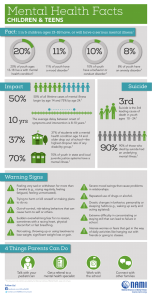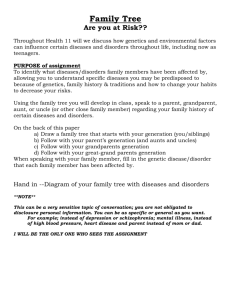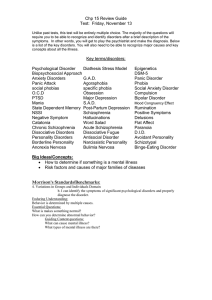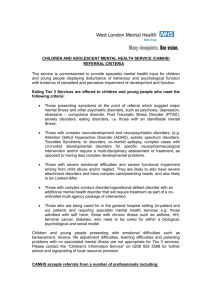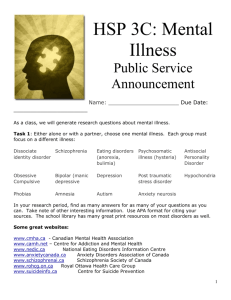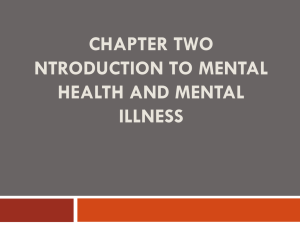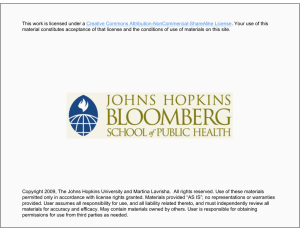PowerPoint Presentation - Wyoming Counseling Association
advertisement
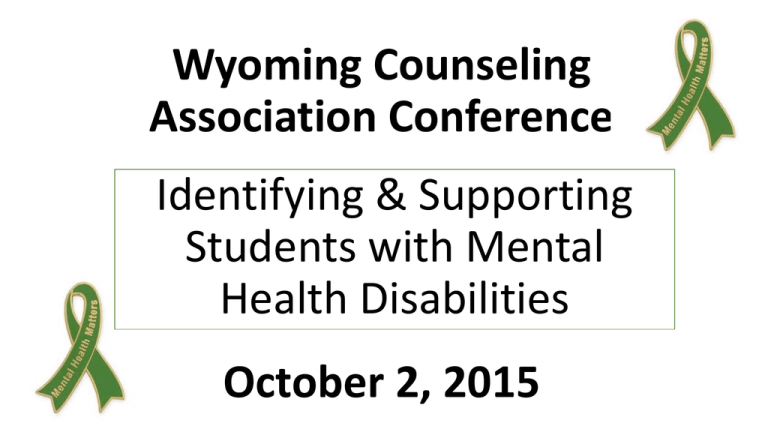
Wyoming Counseling Association Conference Identifying & Supporting Students with Mental Health Disabilities October 2, 2015 Identifying & Supporting Students with Mental Health Disabilities We Need Your Help! Betty Gion – School Counselor Pathfinder High School, Lander, WY Scott Gion – Middle School Principal Wyoming Indian Middle School, Ethete, WY Jacob Gion – Middle School Principal St. Labre Indian School, Ashland, MT Cody Gion- School Psychologist/Doctorate Student University of Oregon, Eugene, OR Facts on Children’s Mental Health in America Prevalence: Of children age 9-17; 21% have a diagnosable mental or addictive disorder. Half of all lifetime cases of mental disorders begin by age 14. It takes 8-10 years on average – from the first set of symptoms to when/if a student receives treatment. In any given year, only 20% of children with mental disorders are identified and receive mental health services. Untreated mental disorder can lead to more severe, more difficult to treat, disorders and the development of cooccurring mental illness. Hmmm . . . 21 children out 100 have a mental health disorder, it will take about 8-10 years to identify these children . . . and in any given year only 4.2 children/100 will receive services. School Failure: 56% of high school dropouts have a diagnosed mental health disorder. Highest dropout rate of any disability group. Top Challenges Addressed in School-Based Mental Health Services Boys Social/Interpersonal or family problems (66%) Aggression or disruptive behaviors (54%) Alcohol/drug problems (34%) Girls Social/Interpersonal or family problems (74%) Depression/grief (47%) Anxiety (36%) Only 32% of students with serious mental illness continue onto postsecondary education. 64% of college students with mental-health issues drop out. (only 7% of parents report their college students as experiencing mental health issues) Suicide: Over 90% of children/adolescents who commit suicide have a mental disorder. 3rd leading cause of death – ages 15 to 24. The rate of suicide for children incarcerated is 4X higher than the general public. Criminal Involvement: Unidentified/untreated youth with mental disorders tragically end up in jails and prisons. 65% boys/75% girls in juvenile detention have at least one mental illness. We are incarcerating youth living with mental illness, rather than identifying their conditions early and intervening with services. References: NAM: National Alliance on Mental Illness The Daily Cougar – Sixty-four percent of college students with mental-health issues drop out ; Christopher Shelton, November 27, 2012 National High School Center; betterhighschools.org; July 2009 How Can I Affect Change? Getting Administrators on Board. 3 Keys Be Persistent Provide Solutions Provide Evidence/Research Social Emotional Learning www.casel.org Positive Discipline PBIS - Effect Size (Teacher Student Relationships) = .72 (Hattie, 2009) Mindfulness – In patients with anxiety and mood disorders, this intervention was associated with effect sizes (Hedges’ g) of 0.97 and 0.95 for improving anxiety and mood symptoms, respectively. Partnerships with Local Agencies Local behavioral/mental health services Youth Dynamics, Altacare, related agencies Outside support/workshops Key is to allow access/tap into resources Academic Programs Direct/Explicit Instruction Effect Size = .59 (Hattie, 2009) Reading Mastery, Corrective Math, etc. ICU Database Effects of Exclusion Student’s with disabilities are twice as likely to be suspended than their non-disabled peers for the same behavior. Suspensions and expulsions are linked to increased rates of future behavior problems, academic difficulty, detachment, and dropout. Schools that suspend more have poorer school climate and lower overall academic achievement scores. Support for……Support Greeting students at the door (increases engagement by 30%) Teaching Expectations (ES= 0.76) Reinforcing positive behavior (ES= 1.17) References: Allan Allday, R., & Pakurar, K. (2007). Effects of Teacher Greetings on Student On-task Behavior. Journal of Applied Behavior Analysis, 40(2), 317–320. http://doi.org/10.1901/jaba.2007.86-06 FACT SHEET: School Discipline and the Pushout Problem http://www.dignityinschools.org/files/DSC_Pushout_Fact_Sheet.pdf Skiba, R., & Sprague J. (2008). Safety without Suspensions: http://www.pbis.org/training/coach-and-trainer Wang, Haertel, and Walberg (1993), Toward a knowledge base for school learning. Review of Educational Research, 63(3), 249-294. Kids Are People Too Maslow's Hierarchy of Needs "Right Here“ by Staind I know I've been mistaken But just give me a break and see the changes that I've made I've got some imperfections But how can you collect them all and throw them in my face Disconnecting Kids and Families from the School. Class Jobs - Privileges Lunch and Recess Celebrations – Incentives – Field Trips Eligibility and Sports Office Referrals and Suspensions Organizations – Clubs – Dances 10 Day Drop Rule Parents Are People Too Doing Things Differently Create healthy school cultures – Anthony Muhammad Build student confidence through success experiences (esteem) Connect all staff, students, and families to the school Rewrite handbooks through the “love/belonging” lens “If you always hope to end up loving and supporting your child, why don’t you just start there?” – Liz Davis
